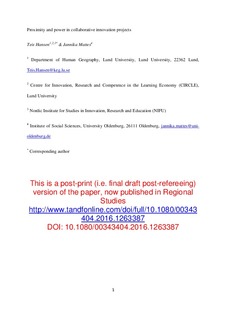| dc.contributor.author | Hansen, Teis | |
| dc.contributor.author | Mattes, Jannika | |
| dc.date.accessioned | 2017-05-29T13:18:09Z | |
| dc.date.available | 2017-05-29T13:18:09Z | |
| dc.date.created | 2017-02-13T12:17:17Z | |
| dc.date.issued | 2017 | |
| dc.identifier.citation | Regional studies. 2017, . | nb_NO |
| dc.identifier.issn | 0034-3404 | |
| dc.identifier.uri | http://hdl.handle.net/11250/2443744 | |
| dc.description.abstract | Proximity and power in collaborative innovation projects. Regional Studies. The proximity literature has so far paid little attention to power relations in collaborative innovation projects. This paper draws on contributions from international business to examine if power constellations between collaborators in innovation projects influence the effects of proximity. An analysis of two cases of collaborations between headquarters and subsidiaries of multinational companies highlights that specific power constellations indeed influence the effects of proximity. While some forms of proximity allow subsidiary-specific capabilities to diffuse throughout the organization and pose a threat to the powerful subsidiary, the weaker subsidiary considers proximity as a possibility to learn from the headquarters. | nb_NO |
| dc.language.iso | mis | nb_NO |
| dc.subject | Proximity | nb_NO |
| dc.subject | Power | nb_NO |
| dc.subject | Multinational companies | nb_NO |
| dc.subject | Headquarters-subsidiary relations | nb_NO |
| dc.subject | Innovation projects | nb_NO |
| dc.title | Proximity and power in collaborative innovation projects | nb_NO |
| dc.type | Journal article | nb_NO |
| dc.type | Peer reviewed | nb_NO |
| dc.source.pagenumber | 12 | nb_NO |
| dc.source.journal | Regional studies | nb_NO |
| dc.identifier.doi | http://dx.doi.org/10.1080/00343404.2016.1263387 | |
| dc.identifier.cristin | 1449909 | |
| cristin.unitcode | 7463,0,0,0 | |
| cristin.unitname | NIFU Nordisk institutt for studier av innovasjon, forskning og utdanning | |
| cristin.ispublished | true | |
| cristin.fulltext | original | |
| cristin.fulltext | postprint | |
| cristin.qualitycode | 1 | |
